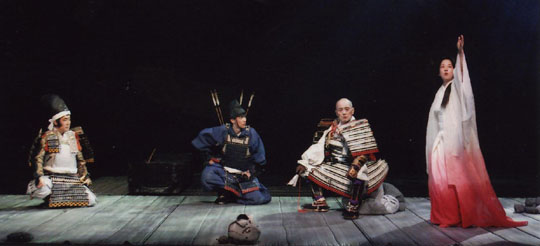What's a nue? A sobbing thrush? A splendid monster? Or the shattered souls of those excluded from society?
In a fascinating two-hour play titled "Nue" by playwright Yoji Sakate, a nue is all three. Presented in the small auditorium at the New National Theater, Tokyo, through July 20, Sakate's production is inspired by a noh play of the same title by Zeami, noh's 15th-century genius, and is intended to instill the philosophical spirit of noh into contemporary theater. Divided into three parts, the 47-year-old Sakate's play has been produced under the direction of 56- year-old Hitoshi Uyama, the art director for the theater, and is performed by one kabuki and three modern drama actors.
The large thrush called a nue is also known as a tora tsugumi due to patterns on its feathers that resemble those of a tiger. Because of the strange cries it makes at night, it was feared by ancient Japanese who believed it to be a chimera with the head of a monkey, the body of a badger, a tiger's paws and the tail of a snake. Zeami, (also called Kanze Motokiyo; 1363-1443) based his play "Nue" on the story of a 12th-century martial hero and poet named Minamoto no Yorimasa (1104-80), who was ordered by Emperor Konoe to kill a nue. The bird's ominous cries at night, which resemble human wailing, were disturbing the emperor, who reigned 1141-55.



















With your current subscription plan you can comment on stories. However, before writing your first comment, please create a display name in the Profile section of your subscriber account page.